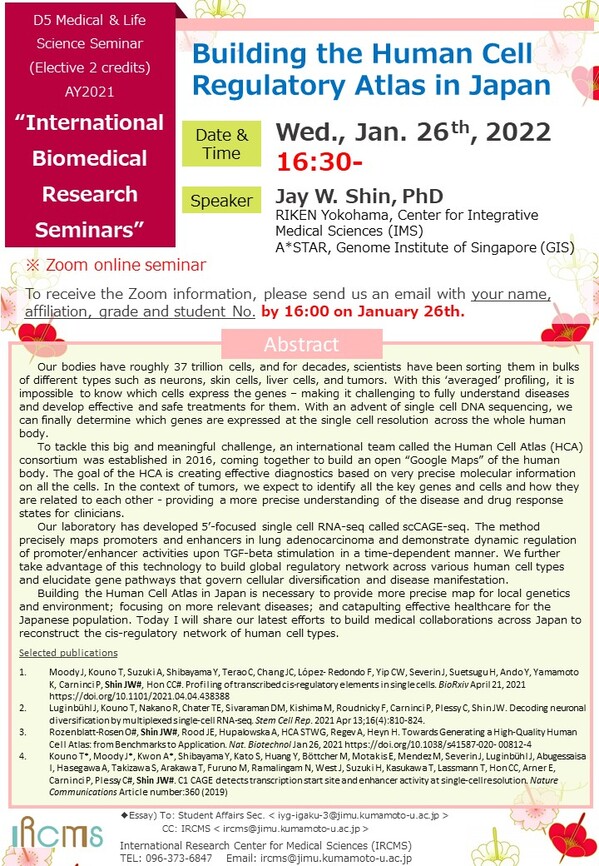- HOME
- News & Events
- [Jan. 26] D5 Medical & Life Science Seminar-Dr. Jay W. Shin
News & Events
[Jan. 26] D5 Medical & Life Science Seminar-Dr. Jay W. Shin
January 4 2022
The "D5 Medical & Life Science Seminar" course will be offered by International Research Center for Medical Sciences (IRCMS). It will run from April 2021 to March 2022, with lectures given by scientists who are affiliated with IRCMS or in collaboration with researchers at IRCMS. The lectures will be given once a month, in English, and by leading scientists in the relevant research field. Students will be taught: 1) how normal physiological functions are maintained in the human body; 2) how these systems become abnormal under certain pathophysiologic conditions; 3) why stem cells are important in animal development and homeostasis; 4) how stem cell-based approaches can help us understand disease mechanisms and find potential cure for diseases related to stem cell malfunction (e.g., cancer, aging).
Date : January 26, 2022 (Wednesday)
Time : 16:30 -
* Zoom online seminar
|
To receive the meeting ID / Password, please send an email to |
Speaker : Jay W. Shin, PhD
RIKEN Yokohama, Center for Integrative Medical Sciences (IMS)
A*STAR, Genome Institute of Singapore (GIS)
Title : Building the Human Cell Regulatory Atlas in Japan
Abstract :
Our bodies have roughly 37 trillion cells, and for decades, scientists have been sorting them in bulks of different types such as neurons, skin cells, liver cells, and tumors. With this 'averaged' profiling, it is impossible to know which cells express the genes - making it challenging to fully understand diseases and develop effective and safe treatments for them. With an advent of single cell DNA sequencing, we can finally determine which genes are expressed at the single cell resolution across the whole human body.
To tackle this big and meaningful challenge, an international team called the Human Cell Atlas (HCA) consortium was established in 2016, coming together to build an open "Google Maps" of the human body. The goal of the HCA is creating effective diagnostics based on very precise molecular information on all the cells. In the context of tumors, we expect to identify all the key genes and cells and how they are related to each other - providing a more precise understanding of the disease and drug response states for clinicians.
Our laboratory has developed 5'-focused single cell RNA-seq called scCAGE-seq. The method precisely maps promoters and enhancers in lung adenocarcinoma and demonstrate dynamic regulation of promoter/enhancer activities upon TGF-beta stimulation in a time-dependent manner. We further take advantage of this technology to build global regulatory network across various human cell types and elucidate gene pathways that govern cellular diversification and disease manifestation.
Building the Human Cell Atlas in Japan is necessary to provide more precise map for local genetics and environment; focusing on more relevant diseases; and catapulting effective healthcare for the Japanese population. Today I will share our latest efforts to build medical collaborations across Japan to reconstruct the cis-regulatory network of human cell types.
Selected publications:
- Moody J, Kouno T, Suzuki A, Shibayama Y, Terao C, Chang JC, López- Redondo F, Yip CW, Severin J, Suetsugu H, Ando Y, Yamamoto K, Carninci P, Shin JW#, Hon CC#. Profiling of transcribed cis-regulatory elements in single cells. BioRxiv April 21, 2021 https://doi.org/10.1101/2021.04.04.438388
- Luginbühl J, Kouno T, Nakano R, Chater TE, Sivaraman DM, Kishima M, Roudnicky F, Carninci P, Plessy C, Shin JW. Decoding neuronal diversification by multiplexed single-cell RNA-seq. Stem Cell Rep. 2021 Apr 13;16(4):810-824.
- Rozenblatt-Rosen O#, Shin JW#, Rood JE, Hupalowska A, HCA STWG, Regev A, Heyn H. Towards Generating a High-Quality Human Cell Atlas: from Benchmarks to Application. Nat. Biotechnol Jan 26, 2021 https://doi.org/10.1038/s41587-020- 00812-4
- Kouno T*, Moody J*, Kwon A*, Shibayama Y, Kato S, Huang Y, Böttcher M, Motakis E, Mendez M, Severin J, Luginbühl J, Abugessaisa I, Hasegawa A, Takizawa S, Arakawa T, Furuno M, Ramalingam N, West J, Suzuki H, Kasukawa T, Lassmann T, Hon CC, Arner E, Carninci P, Plessy C#, Shin JW#. C1 CAGE detects transcription start site and enhancer activity at single-cell resolution. Nature Communications Article number:360 (2019)
Flyer: (Click for a larger image)

